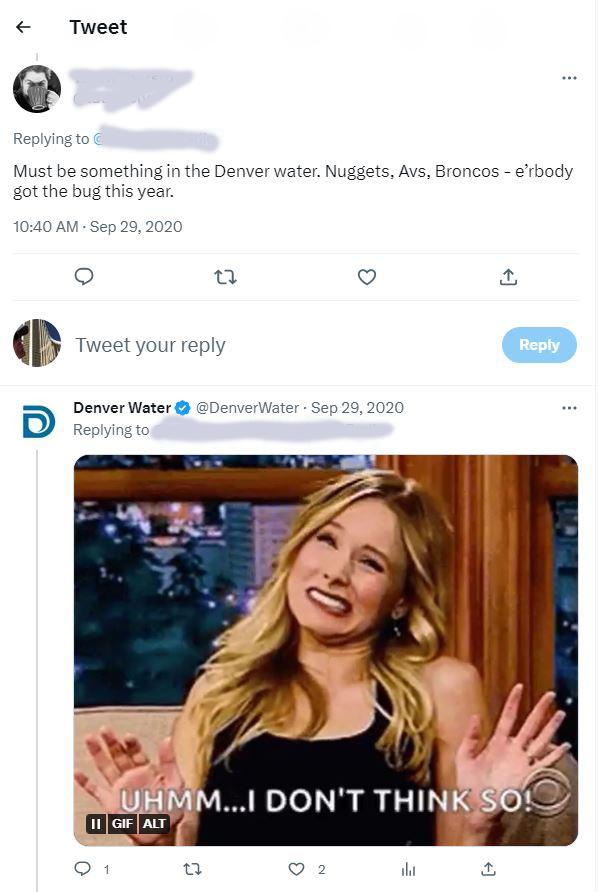Is it the water?
Professional athletes playing in Denver face unique challenges.
Of course, the biggest issue is the altitude. We’re just higher than most U.S cities. (Insert your preferred cannabis joke here. We set you up for it.)
But seriously, just Google “athletes performing at altitude” and you’ll find hundreds of studies done through the years. And they all agree: Altitude impacts athletic performance, for better or for worse.
However, there isn’t a consensus on whether playing at altitude increases an athlete’s chance of being injured.
But when the Broncos, Avalanche and Nuggets players all experienced an alarming number of injuries during their recent seasons, fans start looking for explanations.
Is it the altitude? Their training techniques? Bad luck?
Or is it … the water?
Yes, a few have even reached out to us asking (hopefully jokingly): “What’s in the water in Denver that’s causing all these injuries?”
Subscribe to TAP, the free weekly email dripping with water news. (Scroll down to put your email address in the light blue bar.)
Of course, the simple answer is: There is nothing in the water out of the ordinary.
Drinking water must meet very high standards. All the water we deliver to our customers meets — or goes above and beyond — those high standards. You can see for yourself in our annual water quality report.
But just for fun, we asked one of our water quality experts to simplify it for us. Exactly what is in Denver Water’s water?
Craig McGonagill, an engineering senior specialist in Denver Water’s water quality and treatment section, says there are very few things added to the source water that comes from the snowpack in the Rocky Mountains.
“It’s more about what we take out of the water,” McGonagill says. “We do add chemicals in the treatment process in order to remove things we don’t want in our water, like dirt particles and pathogens. And then most of those chemicals are eventually removed.”
All of Denver Water’s source water goes through a conventional treatment process (summarized nicely here) to create the potable, or drinking water, that is delivered to homes and businesses.
Let’s take a look the process source water undergoes in Denver Water’s treatment plants:
- The first step adds aluminum sulfate and a polymer. These chemicals bind with foreign matter like dirt particles to form large clumps that are removed during the sedimentation and filtration processes.
- In the disinfection process, we mix chlorine with ammonia to create chloramine, which protects against any microbes or pathogens that remain in the water.
- Sometimes we add fluoride, depending on the existing background concentration of it in the source water. Fluoride naturally occurs in many of Denver Water’s supply sources. We add fluoride as necessary to achieve an average concentration equal to the target recommended by the U.S. Public Health Service and the Colorado Department of Public Health and Environment.
And occasionally, we add potassium permanganate, carbon dioxide, lime or caustic soda if we have a taste or odor issue in our source water. All the chemicals are certified as food grade or meeting ANSI/NSF 60 Standards for drinking water additives.
But none of these things caused Gabriel Landeskog’s lingering knee injury or the rash of hamstring pulls that plagued the Broncos this year. Fans will have to keep looking for the source of the mysterious injury bug that keeps biting these players.
Snow drifts standing in the way of a water quality monitoring team? Bring out the snowcat.
And like McGonagill says, Denver Water’s entire focus is providing safe drinking water to promote healthy communities.
“Come to think of it, we do add something else to our water — excellence,” McGonagill says. “We have so many smart, dedicated people watching over the collection, treatment and delivery of our communities’ water supply. It really is inspiring to be a part of.”
“So, when somebody asks, ‘What’s in the water?’ Even if that person is joking, we still take it seriously. We have a very important role to play in public health.”
But yeah, we’re sick of the injuries, too. Let’s all lift a glass of water and toast to good, future health.




